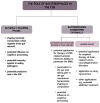Phage Interactions with the Nervous System in Health and Disease
- PMID: 37443756
- PMCID: PMC10341288
- DOI: 10.3390/cells12131720
Phage Interactions with the Nervous System in Health and Disease
Abstract
The central nervous system manages all of our activities (e.g., direct thinking and decision-making processes). It receives information from the environment and responds to environmental stimuli. Bacterial viruses (bacteriophages, phages) are the most numerous structures occurring in the biosphere and are also found in the human organism. Therefore, understanding how phages may influence this system is of great importance and is the purpose of this review. We have focused on the effect of natural bacteriophages in the central nervous system, linking them to those present in the gut microbiota, creating the gut-brain axis network, as well as their interdependence. Importantly, based on the current knowledge in the field of phage application (e.g., intranasal) in the treatment of bacterial diseases associated with the brain and nervous system, bacteriophages may have significant therapeutic potential. Moreover, it was indicated that bacteriophages may influence cognitive processing. In addition, phages (via phage display technology) appear promising as a targeted therapeutic tool in the treatment of, among other things, brain cancers. The information collected and reviewed in this work indicates that phages and their impact on the nervous system is a fascinating and, so far, underexplored field. Therefore, the aim of this review is not only to summarize currently available information on the association of phages with the nervous system, but also to stimulate future studies that could pave the way for novel therapeutic approaches potentially useful in treating bacterial and non-bacterial neural diseases.
Keywords: antibiotic resistance; blood–brain barrier; central nervous system; cerebrospinal fluid; cognitive processing; gut phageome; gut–brain axis; intranasal delivery; phage display; phage therapy; therapeutic phages.
Conflict of interest statement
A. Górski is the co-inventor of patents owned by the L. Hirszfeld Institute covering phage preparations. The other authors declared that the research was conducted without any commercial or financial relationships that could be construed.
Figures


Similar articles
-
Microbiome-phage interactions in inflammatory bowel disease.Clin Microbiol Infect. 2023 Jun;29(6):682-688. doi: 10.1016/j.cmi.2022.08.027. Epub 2022 Oct 1. Clin Microbiol Infect. 2023. PMID: 36191844 Review.
-
Bacteriophages, gut bacteria, and microbial pathways interplay in cardiometabolic health.Cell Rep. 2024 Feb 27;43(2):113728. doi: 10.1016/j.celrep.2024.113728. Epub 2024 Jan 31. Cell Rep. 2024. PMID: 38300802 Free PMC article. Review.
-
The relationship between the phageome and human health: are bacteriophages beneficial or harmful microbes?Benef Microbes. 2021 Apr 12;12(2):107-120. doi: 10.3920/BM2020.0132. Epub 2021 Apr 1. Benef Microbes. 2021. PMID: 33789552 Review.
-
Shining Light on Human Gut Bacteriophages.Front Cell Infect Microbiol. 2020 Sep 10;10:481. doi: 10.3389/fcimb.2020.00481. eCollection 2020. Front Cell Infect Microbiol. 2020. PMID: 33014897 Free PMC article. Review.
-
Bacteriophage-based techniques for elucidating the function of zebrafish gut microbiota.Appl Microbiol Biotechnol. 2023 Apr;107(7-8):2039-2059. doi: 10.1007/s00253-023-12439-x. Epub 2023 Feb 27. Appl Microbiol Biotechnol. 2023. PMID: 36847856 Review.
Cited by
-
The Discovery of Phages in the Substantia Nigra and Its Implication for Parkinson's Disease.Research (Wash D C). 2025 Apr 30;8:0657. doi: 10.34133/research.0657. eCollection 2025. Research (Wash D C). 2025. PMID: 40308709 Free PMC article.
-
Multiomics Analysis Reveals Gut Virome-Bacteria-Metabolite Interactions and Their Associations with Symptoms in Patients with IBS-D.Viruses. 2024 Jun 29;16(7):1054. doi: 10.3390/v16071054. Viruses. 2024. PMID: 39066219 Free PMC article.
-
Bacteriophages-Dangerous Viruses Acting Incognito or Underestimated Saviors in the Fight against Bacteria?Int J Mol Sci. 2024 Feb 9;25(4):2107. doi: 10.3390/ijms25042107. Int J Mol Sci. 2024. PMID: 38396784 Free PMC article. Review.
-
Human Gut Bacteriophageome: Insights Into Drug Resistance Mechanisms in Tuberculosis.Interdiscip Perspect Infect Dis. 2025 Jun 16;2025:8811027. doi: 10.1155/ipid/8811027. eCollection 2025. Interdiscip Perspect Infect Dis. 2025. PMID: 40552317 Free PMC article. Review.
-
Phage-Microbiota Crosstalk: Implications for Central Nervous System Disorders.Int J Mol Sci. 2025 Jun 26;26(13):6183. doi: 10.3390/ijms26136183. Int J Mol Sci. 2025. PMID: 40649960 Free PMC article. Review.
References
-
- Lau H.C.H. Microbiome in Gastrointestinal Cancer. Springer Nature; Singapore: 2023. Gut Microbiome in Health and Gastrointestinal Cancer; pp. 5–21.
Publication types
MeSH terms
LinkOut - more resources
Full Text Sources
Medical

